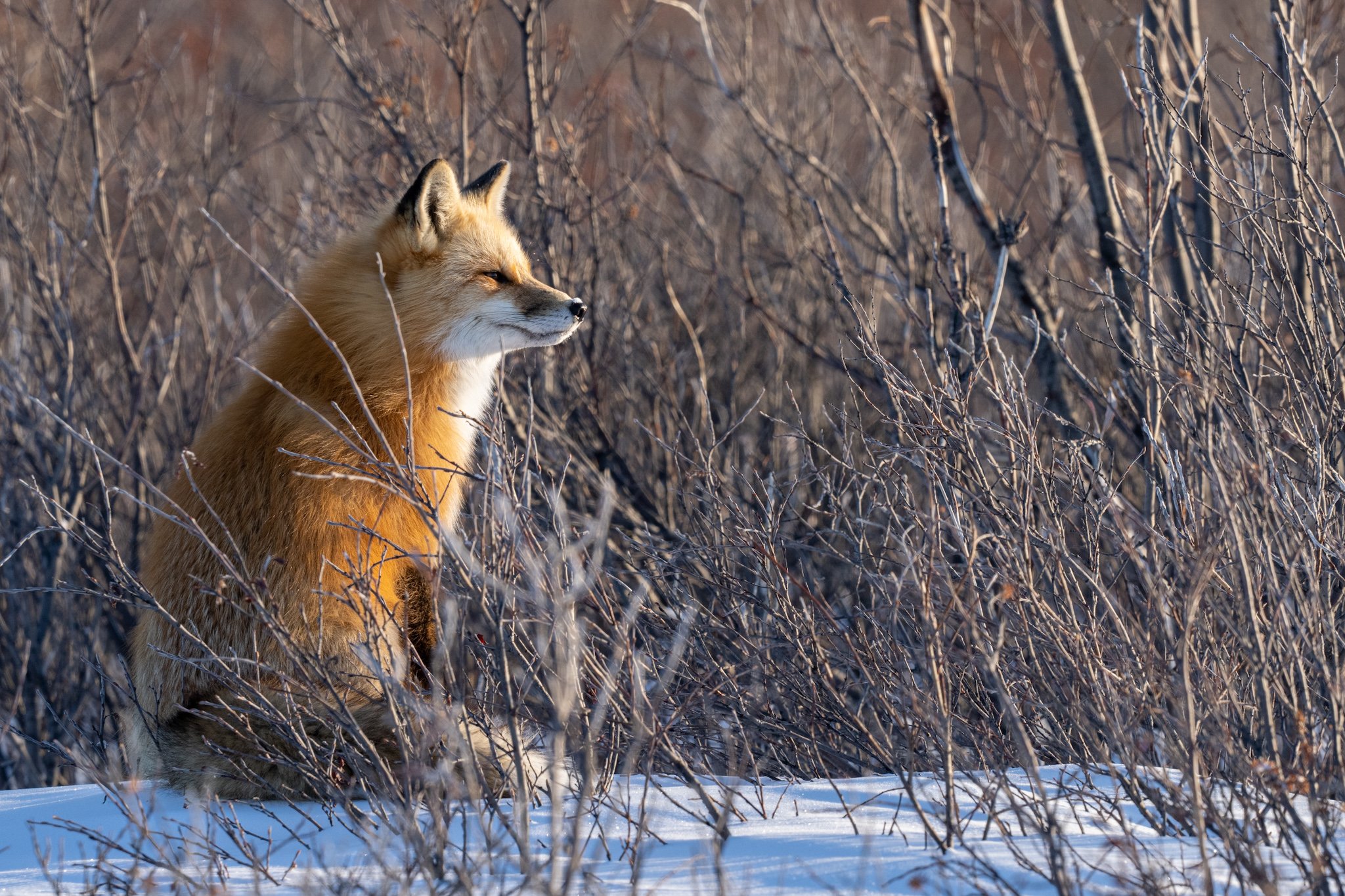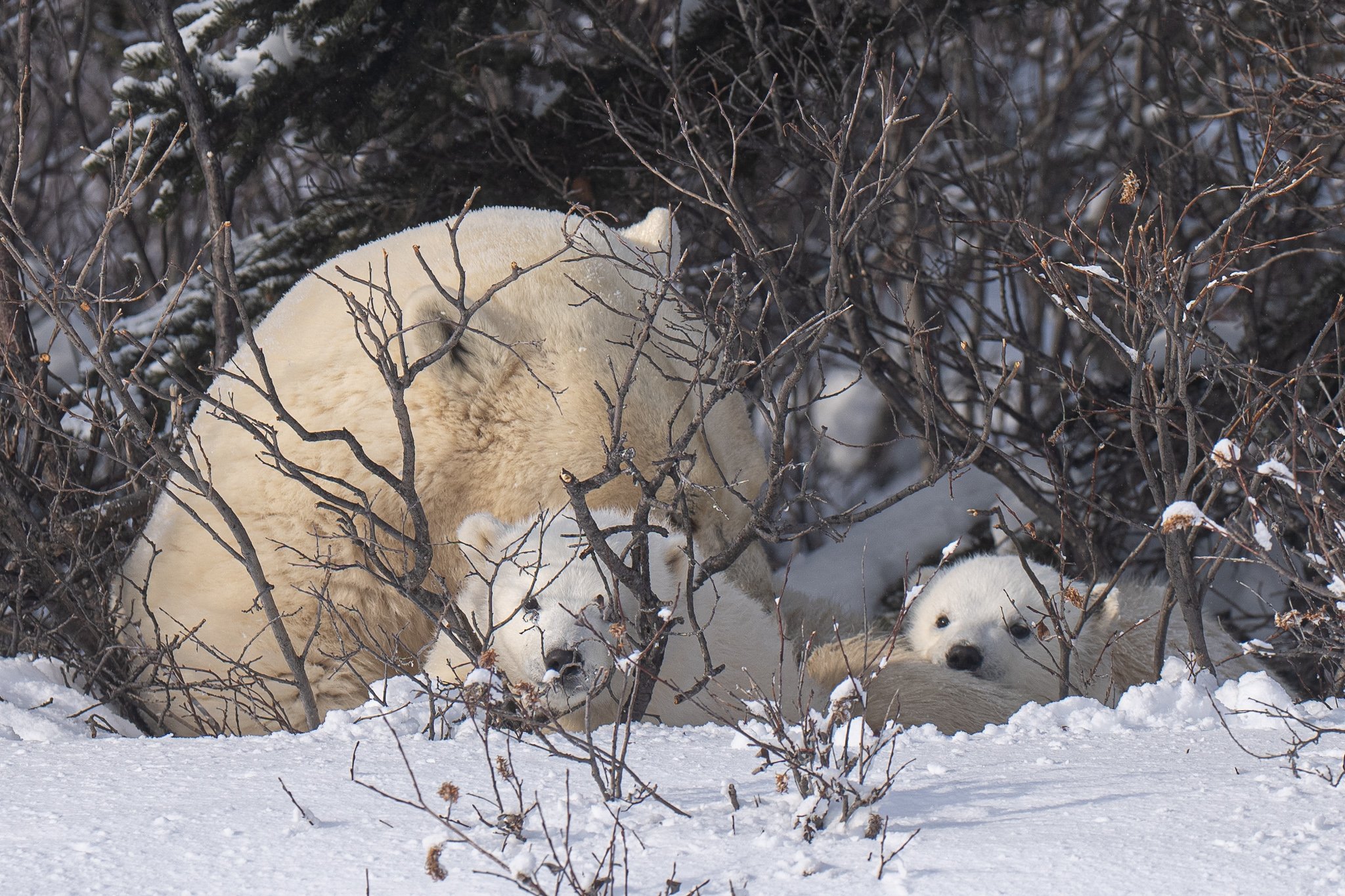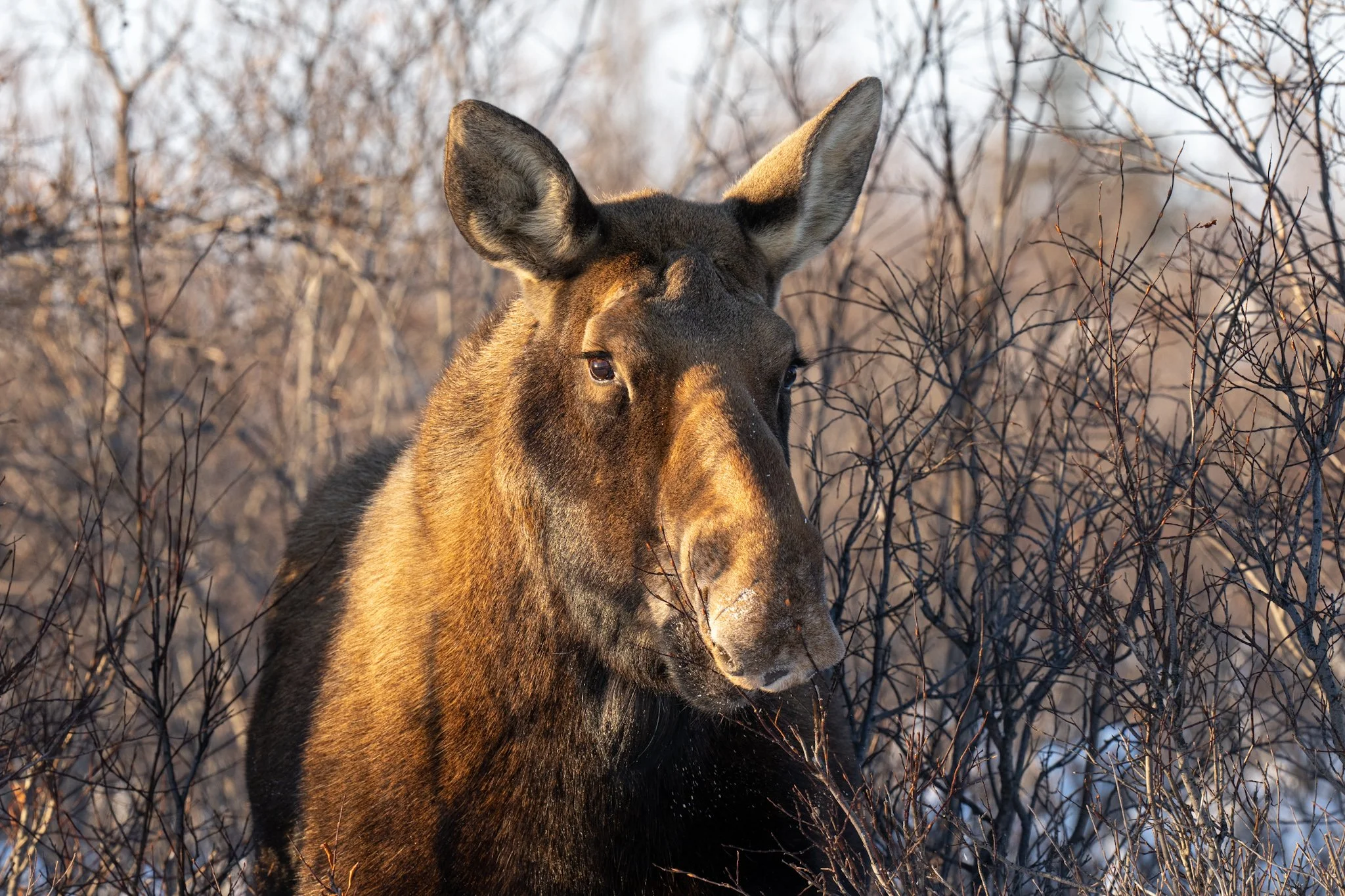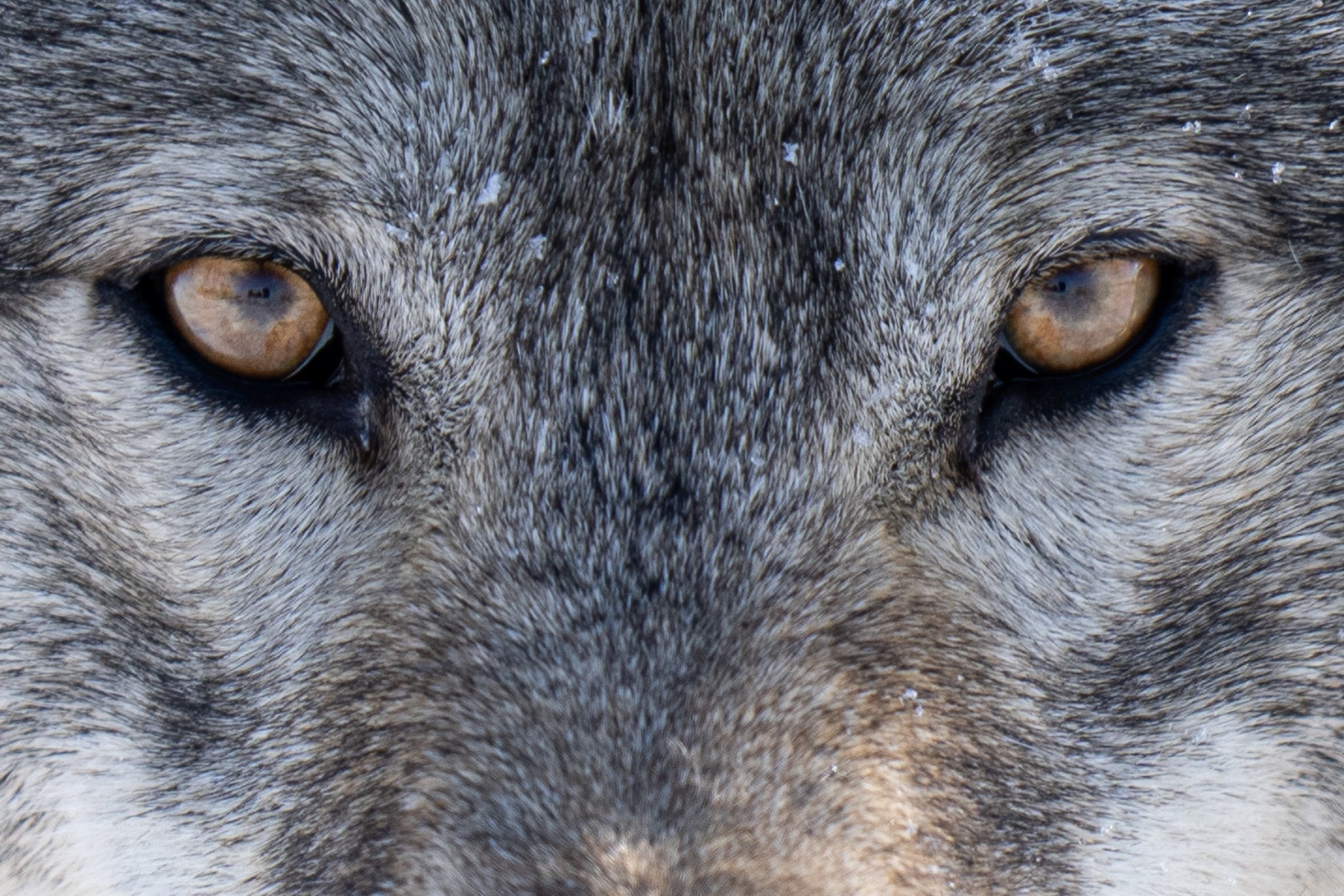Nanuk in Winter 2022
In winter, Hudson Bay is mostly covered with ice. The rivers and lakes are frozen at least a meter thick. Temperatures around -40°C (-40°F) are not unusual, and that‘s without the wind chill. Taking this effect into account, it can feel like -60°C (-76°F). Who would be living in a place like this? And who would even be traveling there? Even in the middle of winter, the coast of Hudson Bay is home to a surprising variety of animals. There are wolves, moose, foxes, owls, other birds and smaller critters like hares and lemmings. And there are polar bear moms with their newborn cubs, making their way from the denning area to the sea ice of Hudson Bay. These are plenty of reasons to put on an additional layer or two and head out into the brutal cold of the Arctic winter.
Preparations
When traveling to the Arctic in winter, you have to be prepared. The cold is not only inconvenient, but it can be dangerous, if you are not dressed properly. Therefore, we packed our warmest merino wool base layers (Icebreaker), heavy fleece jackets (Mammut) and pants (Haglöfs), a down jacket (Canada Goose), two layers of gloves/mitts (Heat Company), warm socks (Falke), a balaclava (OR), a toque (Churchill Wild), a few buffs (Icebreaker/Mammut), our -100°C (-148°F) rated boots (Baffin) and dozens of chemical hand and foot warmers. But when it comes to ski pants and parkas, the rental gear from Churchill Wild is the right choice (FXR/Quartz). The only challenge is to fit all this gear into the weight and size restrictions for the flight to the lodge. This time, we were planning to stay for four weeks, which didn‘t really make packing any easier.
In the cold, you do not only have to take care of yourself, but also of your camera gear. Cameras handle the cold surprisingly well, but a few spare batteries are always a good idea. The most important item to bring, however, is a drybag for your camera. When you bring your camera from -40°C (-40°F) inside the lodge (20°C/68°F), the temperature difference is 60°C (108°F). Condensation will build on (and most likely inside) the camera and will freeze immediately. This can permanently damage your camera. Therefore, you have to put your camera in an airtight bag while still outside. Then you can bring the bag with the camera inside to acclimatize. This way, condensation won‘t happen on the camera but rather on the outside of the bag. Check out our seperate post on cold weather photography for more information.
While we thought, already our own preparations for this trip had been challenging, this was nothing compared to the hardships of opening up Nanuk Polar Bear Lodge from hibernation. We have been told that it takes three to four days until there‘s no more ice on the inside walls of the building. And it will take a similar time to get the water system running. Therefore, the guides and staff arrived more than a week before us to make sure, everything was up and running upon our arrival.
Getting There
Getting to our favorite lodge was a bit more of a challenge than usually. Due to the Omicron variant of COVID, Canada has increased their border measures. Everyone traveling to Canada had to bring a proof of vaccination and a recent negative PCR test. But even with these credentials, all travelers were subject to random testing upon arrival. Being selected for arrival testing meant, that you had to wait for the test results in quarantine. We were aware of this, but decided to do this trip despite the risk of being grounded for a few days. The Government of Canada stated, that it should take 48 to 72 hours to get the results. Therefore, to be on the safe side, we traveled to Winnipeg four days before our flight to the lodge.
Upon arrival, we got the dreaded pink sticker on our passport (which meant we had to take an arrival test at the airport in Toronto). We did so and were allowed to travel on to Winnipeg to quarantine there. We were informed, that it could take up to 5 days to get the results. At that time, we were still hoping for the 48 to 72 hours timeframe, since 5 days would be a problem for our planned flight to the lodge. Well, long story short, after daily changing information from the test center, we finally received our (negative) results after 96 hours, just in time to prepare for our flight to the lodge.
After this bumpy start, everything worked fine. We flew to the remote town of Thompson and then on to the even more remote Nanuk Polar Bear Lodge on an old Otter plane. The flights were smooth and we landed at the lodge on a sunny but very cold winter day.
The Quest
Mating season for polar bears is March or April. However, female bears do not get pregnant immediately. They undergo what is called delayed implantation. If they are healthy and well fed, the fertilized eggs implant in fall. Pregnant polar bears are not spending winter on the sea ice hunting for seals, but are retreating to a denning area further inland. Females seem to have a certain degree of fidelity to the area where they were born. They will give birth to their cubs in a cave, a so called den, made out of peat and snow in December or January. These dens can be anywhere between 50 and 100 kilometers inland. Finally, in February or March, they will be leaving their den and after a few days around their den, the cubs will be strong enough for their most challenging adventure: making their way to mom‘s favorite hunting grounds on the sea ice of Hudson Bay. While most moms have two cubs, some have just one. And very few moms are strong enough to even sustain three cubs.
The journey to the sea ice is filled with dangers for the tiny cubs. Their legs are short, therefore covering more than 50 kilometers is an amazing challenge. Not having the thick layer of blubber like adult polar bears, even the cold can be dangerous to them. And then, there are the wolves, which occasionally predate on cubs. That’s why only 50% of the cubs survive their first year.
Our quest was to spot a polar bear family on their way to the sea ice. And as much as we wanted to witness this, we also wanted to make sure not to interfere with their already challenging journey. Most moms and cubs are walking in a northeastern direction from their denning site. Therefore, our scouts were driving their snowmachines daily on two trails parallel to the coast (east-west), one around 15 kilometers inland, the other 30 kilometers from the coast. Should they discover polar bear tracks back there, we would know that a polar bear family was in an area potentially accessible by us.
Already early in the trip, our scouts discovered tracks from a mom with three cubs. We couldn‘t believe our luck. But the bears were hiding in the boreal forest, about 20 kilometers east of the lodge, near Mistasini River. Since we didn‘t want to miss the moment, we made sure to be at that location from sunrise to sunset. Which, including our almost two hour drive on the snowmachines, meant leaving the lodge around 05:30. One morning, we even saw some faint northern lights when leaving the lodge. We spent long days in the field, usually having breakfast and lunch outside. With temperatures around -40°C (-40°F) and sometimes high winds, we were glad to have a tent for shelter. But our persistence paid off: We eventually spotted the mom with her three cubs just behind some willows. Mom was relaxed and the cubs were playful and curious. We spent the entire day watching them from little more than 100 meters away. They were often sleeping, but suddenly one of the cubs found interest in a small branch, on which it chewed with the determination of a real polar bear. We really felt sorry for having to leave the area just before sunset. But we had to make our way back to the lodge safely.
We went back to the area the next day, but mom had moved her cubs to a different spot. We could still make out their position, but the willows were too thick to really see them. After another long day in the cold, we decided to return the next day. The next morning, on our way east, we spotted wolf tracks. Not just one, but obviously the entire Opoyastin pack. Since wolves predate on polar bear cubs, we were worried about „our“ cubs. But mom was smart: When we arrived at the mouth of the Mistasini River, we discovered the footprints of mom and her three cubs out onto the sea ice. While we would have loved to see them again, we were relieved that they made it out on the sea ice before the wolf pack arrived.
Later in the trip, another mom with two cubs has been discovered by our scouts. This mom, however, was even more elusive. She covered almost 60 kilometers within two days, which is an amazing distance with two cubs. We tried our early morning take-off from the lodge again, but they were already out on the sea ice, when we arrived in the area. We could barely see them with our binoculars. But again, another polar bear family made it safely to the sea ice.
Cloud Wolves
While the first three weeks of our trip were mainly focused on polar bear moms and cubs, the last week was a wolf trip. The wolves around Nanuk Polar Bear Lodge are wild and have never been studied. This is about to change as Churchill Wild, together with National Geographic photographer Jad Davenport, kicked off a new program last year. It is a combination of wolf watching and a citizen science study. Guests can just enjoy the wildlife encounters or can participate in various research activities, like collecting hair or scat samples for DNA analysis, recording howling patterns to try to identify individual wolves or setting up trailcams along the coast and further inland to capture footage 24/7. These wolves are believed to be a subspecies of the grey wolf, called the cloud wolves. But since there has been no research done on them, nobody really knows, yet.
We were fortunate to have incredible wolf encounters on this trip. Sometimes, the entire pack was sticking around the lodge. On two mornings, we even saw and heard a wolf howling inside the fenced compound of the lodge. On these mornings, we obviously just stayed put and watched the wildlife action from the lodge. On another morning, we saw the wolf pack chasing a wolverine up a tree. We didn‘t know that wolves would be chasing wolverines. And we also didn’t know, that wolverines were climbing on trees. Since wolverines are even more elusive than wolves, we decided to get a bit closer to that animal. Upon us approaching, the wolves moved away. But the poor wolverine was even more afraid of us than of the wolves and kept hanging on to his tree top until we left. What a unique encounter!
One morning, we noticed that the wolves were very active already and all animals were covered with blood. We quickly realized, that they must have been successful in hunting an animal. We were assuming that they probably killed a moose. Later that day, we got conformation from our scouts. They had indeed killed a moose about 10 kilometers east of the lodge. Since that poor moose wasn’t going anywhere, we decided to pay it a visit the next day. We made our way to the kill site. It was not a pretty sight and despite the freezing cold, the smell was quite strong. But at the same time, it was fascinating to see this. Even our guides have never seen a fresh wolf kill before. When we arrived there, a red fox was just feeding on the remains. We were kind of surprised, that wolves would not guard their prey, but leave it to other animals as well. That probably meant, that food was plentiful this winter. We set up two trail cams at the site. When we later returned to the site, we discovered, that we put one of the cams too close to the ground, within easy range of the wolves. It was completely chewed up. But both cams captured incredible footage of the wolves returning to their food source. But we also captured a wolverine, foxes and birds feeding on the moose. After three or four days, most of it was gone. Even the bones have largely been chewed away. Nothing gets wasted in the Arctic.
We were using the snowmachines and komatiks to head east and west, and also up the rivers. Whenever we discovered fresh wolf tracks, we tried to follow them. One day, we caught a glimpse of the wolf pack moving east through the willows. But even with our snowmobiles, we had no chance to catch up to them. They can effortlessly cover 50 kilometers a day. The best wolf encounters are when waiting for the wolves to approach us, not vice versa. We did exactly this: we spotted a single wolf about two kilometers out on the coastal flats. We stopped our machines and just waited. Surprisingly enough, the wolf decided to check us out and was trotting straight towards us. He came to within about 10 meters of us. We eventually had to „talk“ him into backing off a little. But wolves are wild animals and don’t like being told what to do. So, he sniffed around for some more and finally, when he decided, it was time to leave, trotted off peacefully. We couldn’t believe our luck - being within less than 10 meters of a wild wolf!
We had another wolf encounter, that was almost as close. But this time, we were watching the wolf from the open decks of the lodge. He climbed onto the snow drifts and was pretty much at eye level with us. Again, we were amazed how curious and intelligent these animals are. This time, the wolf stayed around the lodge for more than an hour, before heading off towards the rest of the pack, out on the coastal flats.
Wild Kaska Coast
While our polar bear and wolf encounters may have been the most touching experiences, we enjoyed the landscape and other wildlife just as much. On two occasions, we spotted great grey owls in the treeline. One was quite far away and the light was already low around sunset. But the other encounter was in bright daylight and from a short distance. These really are incredible birds.
Other wildlife encounters included moose - live moose, not just the one killed by the wolves. It‘s amazing how these „swamp donkeys“ are moving through the willows effortlessly. Even in deep snow, their long legs allow them to walk at an amazing speed. Their main source of food during the long winter months are small twigs and branches. Therefore, moose would not be interested in killing a human. But they easily could, should they feel threatened. A healthy, adult moose can even kill a wolf with their razor sharp hooves and their ability to kick sideways as well as forward and backwards.
One of the most elusive creatures of the Arctic is the wolverine. They are known as skittish, but aggressive, solitary animals. We were therefore quite surprised, when we spotted two wolverines outside the lodge one morning. One disappeared quickly, however.
Foxes are quite common in the area. We saw red foxes, silver foxes, cross foxes and even two Arctic foxes. The latter are rare this far south. One evening, a silver fox caught the attention of the wolf pack, who tried to grab him for dinner. Luckily for the fox, he escaped. Note to ourselves: Wolves and foxes are incredibly fast runners.
Experiencing the Arctic in winter is not just about wildlife, but also about the beautiful landscape, the amazing light and even the occasional storm day. We spent hours photographing huge snow drifts, giant pressure ridges out on the sea ice, clear ice on the rivers and beautiful sunrises and sunsets. And we also saw amazing displays of the northern lights.
Activities
Our four week stay at Nanuk could also be booked as three seperate trips: two Den Emergence Quests and one wolf trip. Therefore, roughly every ten days or so, there was a change of guests. But the activities were so varied, that even staying there for such a long time, there was not a single moment that was boring or dull. Most of the days, we were heading out with snowmobiles that were pulling traditional Inuit sleds, so called komatiks. We were always pulling an emergency toboggan with a tent, two propane heaters and some tools and shovels. The Arctic in winter is not a place to take your chances. Especially in the beginning, when temperatures were even colder, we used the emergency tent as shelter when observing wildlife or having breakfast or lunch out in the field. While lunch out in the field was the way to go on about half of the days, breakfast was usually served at the lodge. And we always returned for dinner. Our longest days were about 13 hours in the field, which meant leaving in the dark and returning after dusk.
A regular day was about 40 kilometers of traveling on the snowmachines and komatiks. This may not sound like a lot, but given the bumpy trails (if any) that‘s not too bad. On some days, we even covered more than 60 kilometers, with lots of driving through thick willows and forest areas. That was pretty adventurous, and exhausting for those driving the snowmachines. But that was still nothing compared to the more than 200 kilometers our scouts covered daily.
In winter, everything looks deep frozen around Hudson Bay. But that‘s not actually true. There are always open patches of water in the bay. There, at the so called floe edge, seals are giving birth to their cubs. Polar bears are never far away, since seals, and especially seal pups, are their main food source. However, this area is usually many kilometers from the coast and therefore off limits to us.
There is also a lot of tidal movement, even in winter. The ice breaks up, water flows on top of the ice and quickly freezes again. Sometimes, entire ice floes are pushed on top of each other, building up huge pressure ridges. These may grow to several meters in heights, making the sea ice extremely challenging to drive on. The tides do not only move the ice on the bay around, but also push water back into the coastal rivers. These will therefore not freeze all the way to the bottom. On one hand, this is positive, since the lodge is getting the water from one of these rivers in winter. On the other hand, there are also cracks and overflows on the rivers. Even at -30°C (-22°F), there can be slush on the rivers or you could drown an entire snowmobile. We had to turn around on several occasions due to large overflow areas even several kilometers up the rivers. And on one occasion, one of our snowmobiles and komatiks broke through the ice and had to be pulled out of about half a meter of freezing water. In the end, everyone was fine, but the entire rescue took more than an hour and several feet got wet.
On a particularly windy day, we stayed at the lodge and started working on weaving traditional snow shoes. It wasn‘t until the last day, that we completed this project and could actually try our own traditional, handmade snow shoes. We were amazed how comfortable they were. They sure beat every modern snow shoe, especially in deep soft snow. While we were using our traditional gear, there were also modern snow shoes and hok skis (a wider version of cross country skis). The entire group had a lot of fun, roaming through the forest and across the frozen swamps around the lodge.
Another project was our igloo: We spent two afternoons building a traditional igloo. It‘s fascinating how well this Inuit winter house protects from the wind and cold. And just as amazing is the silence inside. It‘s like entering a completely different world. The igloo was especially beautiful at night, when we sometimes illuminated it with a flashlight or just with a tealight.
Evenings and nights were always special: On several evenings, the team of the lodge prepared a huge bonfire out on the sea ice. We headed out there before or after dinner and had hot chocolate (with Fireball, a Canadian Cinnamon Whiskey) or mulled wine, together with fire-roasted marshmallows. Enjoying the Arctic sunset out on the sea ice with a bonfire is about as good as it gets!
On other evenings, there were beautiful displays of northern lights. While the aurora borealis can appear anytime during the night, we were fortunate to see them already at a decent time, often just after dinner. Before dinner, during appetizers, or just after dinner, we usually had a presentation on topics like polar bears, wolves, soap stone carving etc. We, Arctic Wild, even had the opportunity to give a talk about our journey around the Arctic.
After four weeks in a remote lodge in one of the most beautiful spots in the Arctic, our amazing trip finally came to an end. We are thankful to have been able to experience this adventure. We are taking home wonderful memories, and a strong urge to be returning to the Arctic! We would like to thank the amazing team of Churchill Wild for making this trip so special.


















